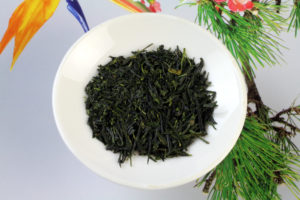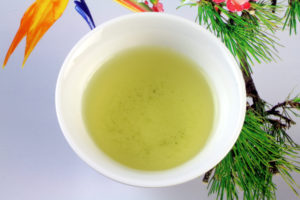Kuchikiri refers to tea that is traditionally stored in a jar and then aged.
This sample from Yunomi is very interesting because it is an organic gyokuro from the Saemidori cultivar.
It’s cultivated in Kirishima, Kagoshima prefecture. But it is refined in Uji, Kyoto prefecture.
I’m currently in quarantine because of the coronavirus pandemic, but at least I can taste a high quality tea like this and get into a better mood 🙂
Let’s indulge in gyokuro
This tea has a fresh aroma with a deep sweetness. It’s very enticing.
The tea leaves have an excellent color. A shiny, dark green.
Some of them are broken down, but the majority have a good shape and size.
I prepared it with 20 ml of water at 60°C (140°F) for two minutes.
The wet leaves have a sweet aroma that is slightly marine and vegetal.
This first infusion has a powerful umami taste with a long and fresh aftertaste.
For a moment, all my troubles are washed away in this light green liquor.
There’s a sweetness about it. And no astringency nor bitterness.
Time for the second infusion.
I used the same temperature but the duration was a minute and a half.
The color of the liquor is a little darker. There’s plenty of umami left, which is great.
Since lowering the infusion time worked last time, I’ll do it again but with a higher temperature. I used 80ºC (176ºF) for a minute, as if it was a sencha.
A similar color, but the umami taste is lighter. It tastes like a normal sencha, very good.
For the fourth infusion I lowered the time to just 30 seconds and kept the same temperature.
Incredibly, it’s still not bitter nor astringent. But there’s not much umami left.
To wrap up this tea session I made the final infusion with boiling water for 10 seconds.
The flavor of this last infusion is quite light, but still worth drinking.
I liked this tea very much. Here’s the product link from Yunomi.







April 22, 2020
Looks like a very nice gyokuro. Thanks for the review. I will check out this company too.
April 22, 2020
HI Bill
Thank you for you comment. It is a nice gyokuro.